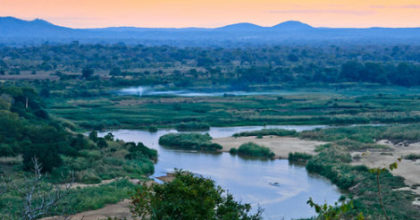
 )
)Mozambique’s Gorongosa National Park was in the science news last week, which caught my eye because I had recently read Sean B. Carroll’s The Serengeti Rules. (Scientist/authors are rare, and yet biologist Sean B. Carroll must distinguish himself from physicist Sean Carroll.) Gorongosa features in the book as one of several locations where large-scale ecological experiments have been conducted under resource management initiatives. The general question is how to achieve a thriving ecosystem with a complete food web in national parks, managed lakes & streams, and other natural resources. In Gorongosa, one of the specific issues is how to keep antelopes and other herbivores from overgrazing. The current research examines whether predator cues such as sounds and smells are sufficient to keep the antelope away from targeted grasslands, or if actual predators and actual predation are necessary.
Carroll’s book blends stories of recent and ongoing ecosystem management projects with molecular biology and tales of pioneering scientists studying the largest and smallest frontiers of biology. Few books combine the story of discovering cholesterol drugs with an adventure in starfish tossing in the Pacific Northwest, but Carroll makes a strong case for taking a broad view of biology. He sees similarities in how biological systems are regulated, regardless of scale. One of these common principles, and one which may not be intuitively obviously, is double negative regulation. In the abstract, A negatively regulates B, and B negatively regulates C. Consequently, more of A means more of C, because more A means less B, and if there is less B then there is less negative regulation on C, hence more C. Got it? No? OK, let’s try a concrete example.
Take elk. No seriously, take an elk, because they had too many of them in Yellowstone National Park. Because there were too many elk, there were fewer aspen and willows, which were getting eaten as shoots by the elk. So the elk negatively regulate the aspen and willows and other vegetation. And what negatively regulates elk? Wolves. But the wolves were eliminated from Yellowstone in the 1930s. In 1995, wolves were reintroduced. More wolves (A) means fewer elk (B) which means more aspen and willows (C). Even more surprising, more wolves means more beaver, because more willows means more beaver (or willows positively regulate beaver).
Yellowstone is just one example. In Wisconsin, to control algae in lakes they introduced bass to eat minnows so that the minnows wouldn’t eat zooplankton, so the zooplankton would eat the algae. In Gorongosa, it was large herbivores that were reintroduced to provide balance to the ecosystem. The specifics vary, but the general principles of regulation are consistent. At the molecular scale, it is the presence and absence of proteins and other molecules that are regulated, such as when bacteria make lactase (C) if the sugar lactose (A) is around because lactose negatively regulates a repressor (B) of lactase production.
Thinking about regulation got me thinking about fasting. Fasting is not the only component of Lenten observance, but it is a widely recognized one. Fasting can serve a variety of purposes, some of which are more about discipline and spiritual orientation than eliminating a bad habit or overindulgence. For example, the purpose of going without food altogether is not realize that you don’t need food. Still, I think there is merit to also examining the ecosystem of one’s life and seeing if there is a need to cut back on something that is out of proportion, and Lent may provide a good time to do that. And I think the regulatory principles of biology may be helpful in that regard.
Maybe in order to cut back on something in your life, you need to add something else. Or maybe there’s something you want more of in your life, but just adding more isn’t working; maybe that’s because you need to add something else first. The particulars–the ABCs–might be specific to your situation, and may take some time to work out. As an example for me, last week I mentioned wanting to reconsider my relationship to technology, or more precisely my relationship to other people as mediated by technology. I’m not satisfied with my social media experience, for example. Yet I’m realizing that social media is my primary way of interacting with almost anyone who isn’t a close family member. It has me wondering if I need to add more in-person socializing if I want to change my social media usage, rather than just trying to cut back.
Have you found examples in your own life where finding balance required more than just adding more of what was lacking or removing what was overabundant?
Andy has worn many hats in his life. He knows this is a dreadfully clichéd notion, but since it is also literally true he uses it anyway. Among his current metaphorical hats: husband of one wife, father of two teenagers, reader of science fiction and science fact, enthusiast of contemporary symphonic music, and chief science officer. Previous metaphorical hats include: comp bio postdoc, molecular biology grad student, InterVarsity chapter president (that one came with a literal hat), music store clerk, house painter, and mosquito trapper. Among his more unique literal hats: British bobby, captain’s hats (of varying levels of authenticity) of several specific vessels, a deerstalker from 221B Baker St, and a railroad engineer’s cap. His monthly Science in Review is drawn from his weekly Science Corner posts — Wednesdays, 8am (Eastern) on the Emerging Scholars Network Blog. His book Faith across the Multiverse is available from Hendrickson.

Leave a Reply